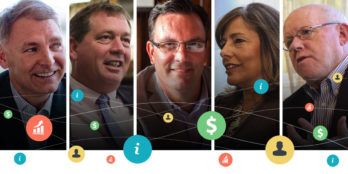
Star Quality: How to Increase Your Quality Rating
 4 min
4 min
When it comes to marketing your skilled nursing facility, quality rating is key. So how can you make sure its quality rating is the best it can be? How can you make your stars shine?
First, it’s important to understand the different components of the Centers for Medicare & Medicaid Services’ (CMS) Five-Star Quality Rating System, which was first introduced in 2008.
The rating system—which is ultimately a tool designed to help consumers compare and choose a skilled nursing facility—assigns each facility a rating between one and five stars. Facilities with five stars are considered to have higher-than-average quality, whereas facilities with one star are deemed to have much lower-than-average quality. There is one overall five-star rating for every nursing home, as well as a separate rating for each of the following metrics:
Health Inspections
The health inspection rating contains data from the past three years of onsite inspections, including both standard surveys and complaint surveys. This metric makes up 60% of a skilled nursing facility’s overall star rating.
Staffing
The staffing rating contains data on the average number of hours that care is provided to every resident, every day, by staff. This rating considers differences in the levels of residents’ care needs in each skilled nursing facility.
Quality Measures
The quality measure rating contains information on different clinical and physical measures for skilled nursing residents. This measurement is intended to indicate how well skilled nursing facilities are caring for their residents’ clinical and physical needs. The number of quality measures included in this metric is ever-changing; CMS added six new quality measures in April 2016.
“To master the ratings process and join the approximately 3,700 skilled nursing facilities that currently have a five-star overall rating, use the following three tips,” says Jayne Warwick, Director, Industry Insight at PointClickCare:
Tip #1: Stay on top of things.
“People tend to think of star ratings only at health inspection time, but really, they should be thinking about them all the time,” Jayne says.
She recommends skilled nursing facilities everywhere begin taking cues from organizations that are doing everything right. The highest-rated skilled nursing facilities are doing audits and inspections regularly, she says, so their staff is used to them.
“This makes audits and inspections routine—not just something to worry about when the state comes to visit,” Jayne says.
She also notes that skilled nursing facilities should be paying attention to their staffing levels and communicating well with the families of their residents to avoid complaints.
At the same time, community leadership should make sure they have minimum data set (MDS) coordinators that are always on top of their quality measures, Jayne explains. Although almost all skilled nursing facilities have MDS coordinators, the best ones always guarantee that all MDS assessments are started on the right date, contain the correct information, are completed by the right people, and are submitted on time, she says.
“Their job is to get you back the money from the state,” she explains. “The more accurate you are, the better you are financially.”
Tip #2: Pay attention to changes.
“It’s really important to pay attention to when changes are made to the quality ratings program,” Jayne says. “It’s key to prepare for what’s coming.”
For instance, the way CMS measures the staffing metric has changed completely from the way the agency measured it last year, Jayne says. In the past, skilled nursing facilities were required to complete a form by hand once a year; now, the form must be submitted electronically each quarter. Skilled nursing facilities now also have to track the attendance and payrolls of anyone who actually delivers care to residents—including therapists and contracted third-party staff.
Many operators have not been doing this. “It’s a huge shift this year,” Jayne says, “That’s going to be the hardest thing for skilled nursing to get over this year because they’ve never done this before.”
To prepare for this change, you must have some way of auditing that the staff members you list actually provided care to your residents, Jayne says. And there are tools out there that can help.
Tip #3: Have the right tools in place.
“A lot of things that could hurt your star rating fall around documentation,” says Jayne. “Documenting it to prove that you did it is key.”
Ideally, your skilled nursing facility will have point-of-care documentation to document care as soon as it is delivered.
“The closer we can bring the documentation to the resident, the more accurate it is,” Jayne says.
You should also use an analytics engine, if one is available to you, to extract accurate and actionable insights on the condition of residents, Jayne adds.
So, what are you waiting for?
Having a five-star overall rating makes a skilled nursing facility stand out to consumers. Follow these tips, and your facility will join the greats.
Click here to learn more about improving your operational efficiency.
Read More: The Case for Data in Senior Care
May 12, 2016






